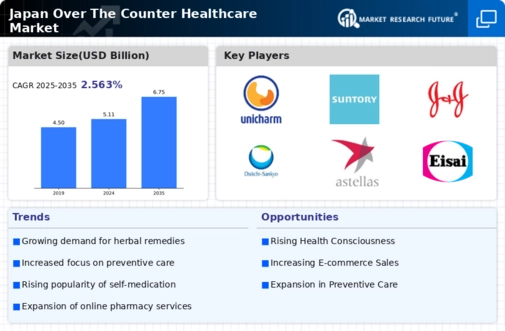Increasing Health Awareness
The growing awareness of health and wellness among the Japanese population is a pivotal driver for the over the-counter-healthcare market. As consumers become more informed about health issues, they are increasingly seeking preventive care solutions. This trend is reflected in the rising sales of OTC products, which have shown a growth rate of approximately 5% annually. The emphasis on self-care and proactive health management is leading to a surge in demand for OTC medications, supplements, and health products. Furthermore, educational campaigns by health organizations are contributing to this awareness, encouraging individuals to take charge of their health. Consequently, the over the-counter-healthcare market is likely to expand as more consumers opt for accessible and convenient healthcare solutions.
Regulatory Support for OTC Products
The regulatory environment in Japan is becoming increasingly favorable for the over the-counter-healthcare market. The Pharmaceuticals and Medical Devices Agency (PMDA) has streamlined the approval process for OTC products, making it easier for companies to bring new items to market. This regulatory support is crucial as it encourages innovation and competition within the industry. In recent years, the number of approved OTC products has risen significantly, with a reported increase of 15% in new product launches. This trend not only enhances consumer choice but also stimulates market growth. As regulations continue to evolve, the over the-counter-healthcare market is expected to benefit from a wider array of products that cater to diverse consumer needs.
Shift Towards Preventive Healthcare
There is a notable shift in Japan towards preventive healthcare, which is significantly influencing the over the-counter-healthcare market. Consumers are increasingly prioritizing prevention over treatment, leading to a higher demand for OTC products that promote health maintenance. This trend is evident in the rising sales of vitamins, dietary supplements, and wellness products, which have collectively seen a growth of around 7% in recent years. The cultural shift towards holistic health approaches is encouraging individuals to invest in preventive measures, thereby expanding the market. As this trend continues, the over the-counter-healthcare market is likely to see sustained growth, driven by consumer preferences for proactive health management.
Rising Demand for Convenience and Accessibility
The demand for convenience and accessibility is a significant driver of the over the-counter-healthcare market in Japan. Busy lifestyles and the increasing preference for self-medication are prompting consumers to seek OTC products that are easy to obtain and use. Retail channels, including pharmacies, supermarkets, and online platforms, are expanding their offerings to meet this demand. Recent data indicates that online sales of OTC products have surged by approximately 20% in the past year, reflecting a shift in consumer purchasing behavior. This trend is likely to continue as consumers prioritize convenience in their healthcare choices. Consequently, the over the-counter-healthcare market is expected to thrive as it adapts to the evolving preferences of the Japanese population.
Technological Advancements in Product Development
Technological advancements are playing a crucial role in shaping the over the-counter-healthcare market. Innovations in formulation and delivery methods are enhancing the efficacy and appeal of OTC products. For instance, the development of smart packaging and digital health solutions is making it easier for consumers to access information and manage their health. The integration of technology in product development has led to a surge in new offerings, with an estimated increase of 10% in tech-enabled OTC products in the last year. This trend not only improves consumer engagement but also fosters brand loyalty. As technology continues to evolve, the over the-counter-healthcare market is poised for further growth, driven by innovative solutions that meet the changing needs of consumers.




















Leave a Comment